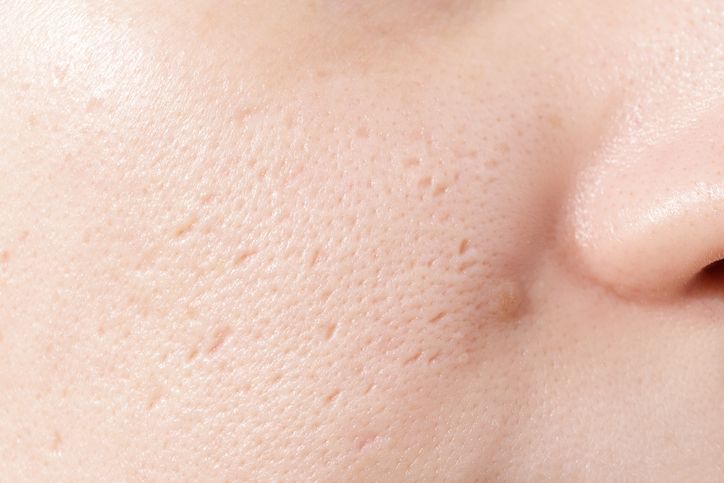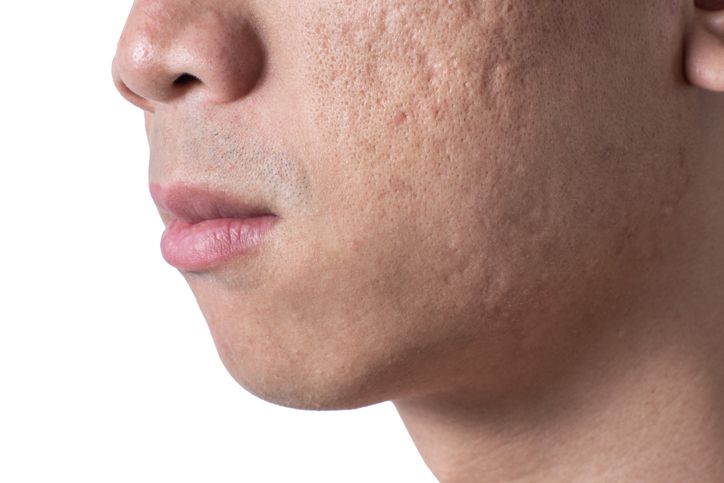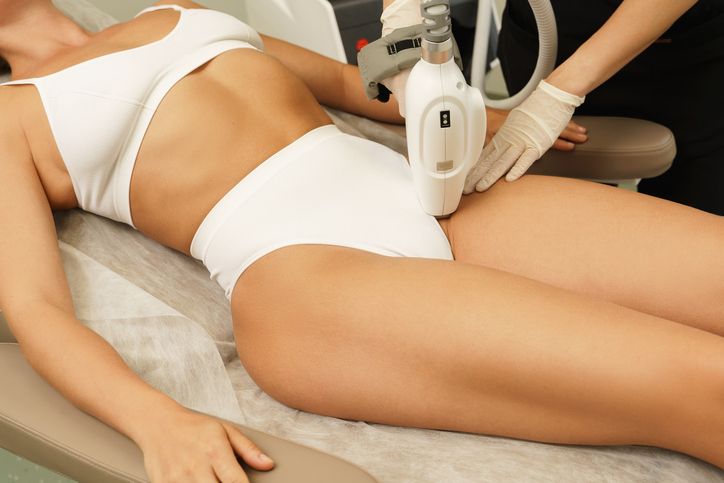- Home
- Trend
- Weight Loss Strategies
- Acne Tips
- Hair Health Information
- Blemish Removal Tips
- Acne Scar Removal Tips
- Muscle Building Techniques
- Intimate Care Tips
- Postpartum Intimate Care
- Eye Bags Wiki
- Tips for Face Slimming
- Secret of Permanent Hair Removal
- Breast Enlargement Tips
- Cure to Snoring
- Marionette Lines
- Skin-Tightening Secrets

免費體驗
Acne Scarring Treatment
1 Minute Self-Registration
Date should not be before minimal date
Dealing with skin imperfections can be challenging, and one such issue that many people face is the presence of ice pick scars. These scars, named for their resemblance to small puncture marks from an ice pick, can affect one's confidence and self-esteem. In this comprehensive guide, we'll delve into everything you need to know about ice pick scars, from their causes to effective treatment options.
1
Among the Crowd of Acne Scarring: Ice Pick Scars

Ice pick scars, also called atrophic acne scars, are often used interchangeably to refer to a specific type of acne scar. Both terms describe scars that result from the loss of tissue beneath the skin's surface, leading to a depressed or pitted appearance. Ice pick scars are a subtype of atrophic scars that are particularly narrow and deep, resembling small, deep holes or "ice pick" punctures in the skin. So, while both terms generally refer to the same type of scar, "ice pick scars" specifically emphasise the appearance of narrow, deep pits.
Ice pick scar primarily develops due to the loss of collagen and tissue that occurs when acne lesions become inflamed and penetrate deep into the skin. The body's natural healing process might not be able to restore the skin's texture perfectly, leading to the formation of these scars. Genetics also play a role, as some individuals are more prone to developing scars than others.
2
How Does Ice Pick Acne Scar Looks Like?

Ice pick scars manifest as a specific subtype of atrophic scars, arising from the disruption of the skin's collagen and elastin framework. When you encounter ice pick scars, you'll notice their distinct presentation: these scars resemble tiny, yet notably deep, indentations that seem to punctuate the skin's surface. Imagine the surface of your skin resembling the texture of the moon's surface, with these small depressions scattered across it. Their appearance is reminiscent of the impression made by an ice pick, hence the name.
To determine if you have ice pick scars, a simple self-test can be conducted. Gently examine your skin, paying close attention to areas that have experienced severe acne outbreaks. Ice pick scars are particularly common in regions where inflammation from blemishes has disrupted the natural structure of the skin during the healing process. If you spot these small, pitted holes that differ from the overall texture of your skin, you might indeed be dealing with ice pick scars.
3
Why are Ice Pick Scars Often Considered as the Worst Scar?

Ice pick scars are often considered some of the most challenging and impactful types of scars due to their distinct characteristics and the way they affect the skin's appearance. Here's why ice pick scars are often perceived as among the worst scars:
1. Depth and shape
Ice pick scars are characterised by their deep and narrow appearance, resembling tiny punctures or "ice pick" marks on the skin's surface. The depth of these scars makes them particularly difficult to treat and diminish.
2. Stubbornness
Ice pick scars tend to be more resistant to common topical treatments and at-home remedies. Their deep nature makes them less responsive to superficial treatments that might work for milder scars.
3. Texture disruption
The pitted appearance of ice pick scars disrupts the smooth texture of the skin. This unevenness can be challenging to conceal with makeup or other cosmetic methods, contributing to a noticeable and sometimes distressing appearance.
4. Long-lasting impact
Without proper intervention, ice pick scars can persist for years or even a lifetime. Their deep-seated nature means they might not naturally improve over time like some other types of scars.
5. Psychological impact
The visible presence of ice pick scars can have a significant psychological and emotional impact on individuals. They might lower self-esteem and self-confidence, potentially affecting social interactions and overall well-being.
6. Complexity of treatment
Treating ice pick scars often requires more intensive and targeted approaches, such as laser treatments, chemical peels, or microneedling. These procedures can be costlier and may require multiple sessions for noticeable improvement.
4
Can Ice Pick Scars Develop Into Deep Scars and Affect My Skin Layers?

These scars have the potential to evolve and impact deeper layers of the skin tissue. Initially, ice pick scars start as small, narrow depressions on the skin's surface. However, if left untreated, they can worsen over time and extend deeper into the skin's layers.
As the scars progress, they might expand in width and depth, affecting not only the surface but also the underlying dermal layers. This can lead to further disruption of collagen and elastin fibres, causing the scar to become more pronounced and altering the overall texture of the skin. In some cases, severe ice pick scars can even contribute to the appearance of uneven skin contours and texture irregularities.
It's important to address ice pick scars early on to prevent them from becoming more deeply entrenched and affecting multiple layers of the skin or your overall skin texture.

免費體驗
Acne Scarring Treatment
1 Minute Self-Registration
Date should not be before minimal date
5
Prevention and Early Intervention for Ice Pick Acne Scars

While complete prevention of ice pick scars may not always be possible, early intervention can minimise their severity. Avoiding picking or squeezing acne lesions is crucial to prevent further damage. If you're prone to acne, here's a few treatments to reduce the risk of scarring.
1. Chemical peels
Chemical peels involve the application of a chemical solution to the skin, causing controlled exfoliation and promoting the growth of new skin cells. This procedure can help improve the texture of the skin and reduce the appearance of ice pick scars over time. However, potential downsides include temporary skin redness, irritation, and sensitivity following the peel. In some cases, more aggressive peels may require downtime for healing, and there's a slight risk of hyperpigmentation or hypopigmentation, especially in individuals with darker skin tones.
2. Micro needling
Microneedling, or collagen induction therapy, utilises tiny needles to create controlled micro-injuries in the skin. This stimulates collagen production and enhances skin's texture, reducing the depth of ice pick scars. Yet, it's important to note that microneedling might cause temporary redness and swelling immediately after the treatment. In inexperienced hands or if not properly sanitised, there's a risk of infection. Also, multiple sessions are usually needed for significant results.
3. Dermal fillers
Dermal fillers containing substances like hyaluronic acid can be injected into ice pick scars to elevate the skin's surface and make the scars less noticeable. Results are temporary but can provide immediate improvement. The potential downside is that filler injections may cause slight bruising, swelling, or redness at the injection sites. In rare cases, there's a risk of unevenness or lumps under the skin.
4. Laser resurfacing
Laser treatments target the damaged skin layers, promoting collagen remodelling and skin rejuvenation. Fractional laser therapy can significantly improve ice pick scars by gradually filling in the depressions. However, laser treatments can be associated with temporary discomfort during the procedure and redness afterward. Individuals with darker skin tones are at a higher risk of hyperpigmentation if post-procedure care isn't meticulously followed.
5. Subcision
Subcision is a minor surgical procedure where the scar tissue is detached from the underlying skin, allowing new tissue to form and elevate the scars. This method is particularly effective for deep ice pick scars. Despite being minimally invasive, subcision can lead to temporary bruising, swelling, or tenderness at the treatment site. Infection and scarring are rare but possible risks associated with any surgical procedure.
6
What Skin Care Ingredient is Good for Ice Pick Scars?

You might have heard of salicylic acid, which is one of the acids that can be beneficial for treating ice pick scars. It's a beta hydroxy acid (BHA) that is often used in skincare products for its exfoliating and pore-clearing properties. Salicylic acid can help improve the appearance of ice pick scars by:
1. Exfoliation
Salicylic acid exfoliates the outer layer of skin, encouraging the shedding of dead skin cells. This can help improve the texture and smoothness of the skin, making the edges of ice pick scars less noticeable.
2. Unclogging Pores
Ice pick scars can be associated with enlarged pores. Salicylic acid is oil-soluble, which means it can penetrate into the pores, helping to clear out debris, excess oil, and dead skin cells that might contribute to the appearance of scars.
3. Promoting Skin Renewal
By exfoliating and encouraging cell turnover, salicylic acid can support the skin's natural healing processes and promote the growth of new, healthier skin cells.
4. Anti-Inflammatory Effects
Salicylic acid has anti-inflammatory properties that can help reduce redness and swelling associated with scars, making them appear less prominent.
It's important to note that while salicylic acid can be effective for improving the appearance of ice pick scars, results may vary depending on the severity of the scars and individual skin types. If you're considering incorporating salicylic acid or any other acid into your skincare routine, it's recommended to do a patch test first and consult a dermatologist to ensure it's suitable for your skin and to determine the appropriate concentration and application frequency.
- Tighten Pores With Ease: 5 Mistakes That Could Be Holding You Back
- How Effective Is Acne Scar Creams with Acid? A Must Read For People With Sensitive Skin
- Acne Scarring Fillers: Why & How It Can Fix Your Scar Problems
- 5 Different Types Of Acne Scars You Have To Know: Discover Causes And Solutions For Clear Skin
7
Skin Scars No More: Treat Ice Pick Scars and Other Acne Scars with Acne Scarring Treatment

At Perfect Medical, we're no strangers to the battle against these skin foes. If you're after a way to tone down those skin imperfections without upsetting your skin's delicate balance, your search ends here. Enter the realm of Perfect Medical's Acne Scarring Treatment, where the spotlight shines on the remarkable 1064nm laser technology. This groundbreaking method dives deep into your skin's layers, powered by photothermal action, to dismantle excess melanin—often a troublemaker in acne—and let your body naturally dispose of it. This laser power doesn't stop there; it sparks the creation of collagen and elastin, crucial players in repairing skin tissues and fostering that supple feel.
This all-encompassing treatment is a game-changer for various acne scar types. From those pesky rolling scars, hypertrophic marks, and raised spots to the trickier atrophic scars, boxcar acne remnants, pigmented brown and red patches, and even the determined ice-pick scars—our approach leaves no stone unturned. Our technique also blends a lively two-way spiral suction and drainage strategy. This savvy move thoroughly purifies and exfoliates your pores, evicting unwanted guests like excess oil, stubborn dirt, and lacklustre dead cells.
After the treatment, the professional will usher in a specialised medical-grade hydrating serum. It elegantly infuses into your pores, delicately restoring the equilibrium between water and sebum, while giving a hearty boost to collagen production. By dialling down excess sebum and delivering a deep cleanse, we put an end to future acne outbreaks. The result? Skin that feels remarkably smoother, radiates a brighter glow, boasts an impeccable clarity, and lays the foundation for better health.
This transformation isn't just skin-deep; it extends to a surge of self-assurance. Plus, it guards against the emergence of deeper scars, even for those with darker or uneven skin tones. So, this is the perfect way to get rid of your ice pick scars and other type of stubborn acne scars! Embark on this transformative journey by choosing Perfect Medical's Acne Scarring Treatment today!
8
Last Few Words

Ice pick scars can be a source of frustration, but there are effective treatments available to improve their appearance and boost your confidence. Whether you opt for chemical peels, microneedling, dermal fillers, laser resurfacing, or subcision, consulting a dermatologist is key to achieving the best results. By understanding the causes, prevention methods, and treatment options, you're well-equipped to take control of your skin's health and vitality.

免費體驗
Acne Scarring Treatment
1 Minute Self-Registration
Date should not be before minimal date
FAQ

1. Are ice pick scars more common in certain skin types?
Ice pick scars are not exclusive to specific skin types; they can manifest across various skin tones and types. However, it's worth noting that individuals with darker skin tones might face an additional concern – the possibility of post-inflammatory hyperpigmentation. This condition can cause areas around ice pick scars to darken temporarily, making them more noticeable. This emphasises the importance of tailored skincare approaches for different skin tones.
2. Are at-home remedies effective for treating ice pick scars?
While at-home remedies can be a part of skincare routines, they often yield limited results when it comes to treating ice pick scars. These scars involve structural changes in the skin's deeper layers that require more targeted interventions. Professional treatments, like laser therapies, chemical peels, or micro-needling performed by dermatologists, tend to be more effective in achieving significant improvement in the appearance of ice pick scars. Consulting a skincare professional can help determine the most appropriate course of action.
3. Can makeup conceal ice pick scars?
Makeup can be a valuable tool for temporarily concealing ice pick scars and achieving a smoother appearance. Skilled application techniques and the use of specialised products, such as primers and full-coverage foundations, can help minimise the visibility of scars. However, it's important to recognize that makeup offers a cosmetic solution rather than a permanent one. It's not a substitute for treatments designed to address the underlying causes of ice pick scars. For a longer-lasting improvement, exploring dermatological treatments alongside makeup techniques might be a more comprehensive approach.
4. What is punch excision, and how does it relate to treating pitted acne scars?
Punch excision is a surgical technique employed to treat pitted acne scars, particularly those that are deep and well-defined. In this procedure, a circular tool, known as a punch biopsy tool, is used to carefully remove the scar tissue. The resulting wound is then either sutured or allowed to heal naturally, encouraging the growth of new skin in the treated area. This method is effective for addressing pitted scars by essentially excising the scarred tissue and promoting the regeneration of smoother skin in its place.
5. Can effectively managing inflammatory acne help prevent the formation of scars?
Yes, taking proactive measures to manage inflammatory acne can significantly reduce the risk of developing scars. When acne is left untreated or becomes severe, it can damage the skin's structure and collagen, leading to scar formation. By promptly addressing inflammatory acne through proper skincare, targeted treatments, and, if necessary, under the guidance of a dermatologist, you can help minimise the chances of scars forming in the first place. Preventing inflammatory acne from progressing can ultimately contribute to smoother and clearer skin without the burden of subsequent scarring.









